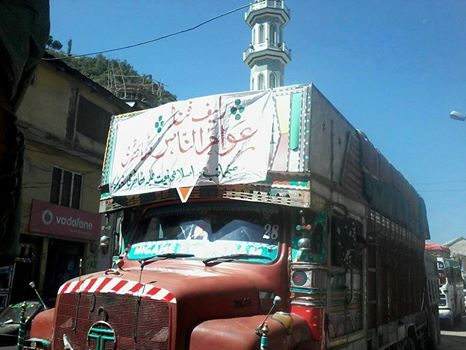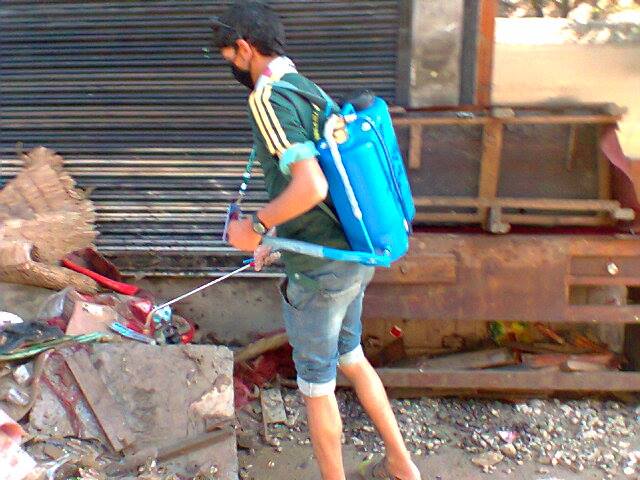Their founder Moulana Maududi called Jama’at as ‘the helpers of God,’ who were seen rescuing and providing relief to flood-hit recently. Bilal Handoo sums up Jama’at-e-Islamia’s work during the deluge along with their chequered history

It was unusual news that New Delhi run Radio Kashmir aired on September 5. In their evening bulletin, the lead news read: Keeping valley’s worsening flood situation in view, Jama’at-e-Islami (JeI) has asked its cadre to turn their local units into relief camps and be ready for rescue and relief operations.
Those who were glued to their radio sets that evening and were aware of the chequered history of Jama’at had a flashback…
It was 1975. Emergency was declared in India by the “only man in her cabinet”—Indra Gandhi. The daring daughter of Nehru had also banned Jama’at in mainland India. Back in Jammu and Kashmir, Sheikh Mohammad Abdullah (then J&K chief minister) who had ended the Plebiscite Movement by signing Indira-Abdullah accord extended the ban on Jama’at in J&K state.
As a result, hundreds of Jama’at run schools were “forcibly” closed down rendering hundreds of educated youth working in these schools unemployed.
Almost 40 years later…
The historic floods caught the government of Sheikh’s grandson napping. Omar Abdullah’s men and machinery couldn’t save 70 per cent of Kashmir’s capital from flood. It was indeed a historic failure where his government almost disappeared from the scene. A vacuum was created which was fittingly filled by Jama’at besides others.
Meanwhile, the radio announcement had created its impact. A day after, a Jama’at team started moving from Shopian to Srinagar. They entered the city with nine chefs, hundreds of rice bags, boats and other relief material in 16-wheeler trucks. The camp was started from Girls Higher Secondary School Batamaloo.
And soon rescue operations started. The Jama’at team saved scores of stranded people including Press Information Bureau’s Kashmir based official Obaid-Ur-Rehman. While rescuing Rehman from Hotel Apex at Rajbagh Srinagar, they saw a girl from Doda frantically searching for her lost brother. In front of their eyes, the girl drowned to death. They tried, but couldn’t save her. Later they fished out her body and sent it to her home.
There was one brave-heart in Shopian rescue team, Shabir Mir, 25. “What we witnessed in Srinagar were heart-breaking scenes,” he says. “I saw a boy drowning near Iqbal Park who was pleading an army boat sailing around to save his life. But army didn’t budge. This callousness infuriated me. I shouted at army, but they left without rescuing the boy. And then I jumped into the water and rescued that boy.”
But before Jhelum unleashed hell in Srinagar, it had devastated South Kashmir. To respond the grim situation, Jama’at had setup rescue and relief operations in Southern Kashmir on September 4. And soon similar camps started cropping up from Litter to Lalbazar, from Batapora to Batamaloo and from Shangus to Soura.
With the dawn of September 7, Jama’at made another announcement, this time through print media, asking its workers to be on their toes. The announcement mobilised thousands of Jama’at workers from countryside to city. Jama’at workers especially from unaffected areas like Ganderbal, Sopore, Baramulla and Kupwara rushed to the city in droves.
Those who were moving towards Srinagar were JeI members (who constitute Jama’at’s general body). Besides two more cadres: likeminded and sympathizers volunteered for the cause. The like-minded workers are qualified JeI members (but not part of general body), while as sympathizers have sympathy for Jama’at.
As the support mounted, another relief camp cropped up at Srinagar’s Soura area where apart from relief distribution, a post operative care unit was setup for patients.
JeI Kashmir is a cadre based religo-political organization, distinct from the JeI Hind. The stance of JeI Kashmir is: “J&K is a disputed territory.”
JeI was initially established before Shiekh Abdullah led government replaced the Dogra Monarch rule in J&K in 1947. The formal unit of Jama’at was formed in 1946 as a library or Darul Muta’la at Nawab Bazar, Srinagar. Moulana Saad-Ud-Din (then headmaster) was elected as its first head.
Later JeI framed its own constitution after Sheikh Abdullah’s arrest in 1953. Moulana Saad-Ud-Din was elected as the first Ameer-e-Jama’at under this constitution.
However, Jama’at had to face music for raising the issue of right to self determination, says Mushtaq Ahmad, a city-based Jama’at worker: “It [Jama’at] contested assembly and parliamentary elections many times to press for the issue of self determination effectively and succeeded on five assembly seats.”
It is said that once inside the assembly, the elected members of Jama’at demanded the implementation of Islamic rule in the state besides pitching for the right to self determination. “The result was obvious,” continues Ahmad, “Jama’at workers would be often thrown into jail.”

In between, the day, April 4 (1979), dawned. The day etched in the memories of every Jama’at worker as a black day! A wave of anti-Jama’at protests had erupted in Kashmir that spring. The trigger was the execution of Zulfikar Ali Bhutto (the former prime minister of Pakistan). The day Bhutto was hanged; no strike was observed in Pakistan. “But thousands of houses belonging to Jama’at cadres and sympathizers in Kashmir were torched by the unruly mobs,” says Kaiser Bhat, a Jama’at worker from Shopian. “Apple orchards of Jama’at sympathizers (spread on swathes of land) were axed and uprooted.”
This mad show continued for three days with the then government looking as a mute spectator, claims Bhat: Libraries with Islamic books were torched. And even, Bhat continues, the holy Quran was desecrated at many places for being “Maududi Quran.”
Back in 2014, a wave of panic and poignancy triggered by floods was building over city on September 7. And to address the needs of mounting chunk of flood-hit, Jama’at drove truckloads of 500 quintals rice and 200 quintal of vegetables from South Kashmir’s Kulgam to city. As the relief material started piling up, the headquarters of Jama’at’s educational department at Nowgam was converted into central relief committee office.
Soon, Jama’at started packing the relief material in family kits. Around 19 items were kept in a single kit, including 10 kg rice, ½ kg vegetable oil bottle, tea, spices, biscuits, baby food, blanket and other essentials. At many places, mattresses and quilts were also distributed. All the relief material was being dispatched from central relief centre (Nowgam) to other local units-turned-relief camps which would then distribute it to affected areas.
“In fact,” says Ess Ahmad Pirzada, Jama’at‘s press and publication officer, “the first relief truck which reached Rajbagh was sent by Jama’at.”
As per the latest estimation, some 1500 to 1700 quintals of rice, 900 quintals of vegetables and two truckloads of mineral water have been distributed by Jama’at so far among the flood-hit across the valley.
All relief material, says Pirzada, came from public donation. “Now after rescue and relief work,” he says, “Jama’at is now meeting with their local unit heads to plan a comprehensive strategy for rehabilitation.”
In recent past, Jama’at was banned and declared an unlawful association. In 1990, all its offices were locked down by the local administration. It is believed that Jama’at workers were made the “fodder of conflict cannon” as per the “well-hatched ploy”.
Somebody like Kaiser Bhat who lost one of his uncles along with three other Jama’at sympathizers believes Jama’at killings were done with deliberate motive and intention. “Apart from my uncle, thousands of associates of Jama’at were killed by army and other counterinsurgency forces,” he says. “They were silenced simply because they kept pressing for right to self determination– something which was/is unacceptable to New Delhi.”
Among the slain, it is said, were many intellectuals and dignitaries. Besides, thousands of Jama’at associates were detained in notorious torture and detention centers where they were “ruthlessly” tortured.
Finally in 1998, Jama’at reopened its head office at Baranpather Batamaloo after Ghulam Mohammad Bhat was elected its Ameer. Gradually the offices in districts too were reopened and Jama’at restarted its functioning. “But the intermittent killing of Jama’at people continued during this period as well,” claims Bhat.

In recent floods, Islami Jamiat-e-Talaba (IJT), the student wing of Jama’at camped at different parts of valley “tirelessly” providing rescue and relief to flood-hit. Hundreds of youth associated with Jamiat were also seen sanitizing the city after Jhelum receded and left behind putrefying stink and stack of slush.
Some 100 Jamiat workers did fumigation and removed carcasses from the city on daily basis. “After we started fumigating the city,” says Umar Sultan, President IJT, “Srinagar Municipal Corporation followed.” The youth wing of Jama’at have also organised many medical camps for the flood-hit.
Sultan who is bright-faced young man having Masters in Media recalls one heart-wrenching ‘riches-to-rags’ story that unfolded at Jamiat’s relief camp at Soura.
A lady approached the camp supervised by Sultan and asked for a rice bag. After receiving the bag, she insisted Sultan and his team to accept money. But the relief team refused the same saying, “it is relief material for the needy, and, not for sale!”
While carrying a rice bag to woman’s car, Sultan saw her husband crying like a baby! That man, the woman told Sultan, was a rich man who lost everything in the flood. “During my stay at the camp, there was no end of such stories,” he says.
Jama’at, its founder Moulana Maududi once said, is an all encircling movement, “As such, its task is uphill!” It needs man power, he further said, to ‘change the whole system’ of this world.
What JeI founder thought about his founding organisation was recently visible in valley when entire JeI cadre got reduced into rescue and relief team.
While praises are piling up for Jama’at’s role in recent floods, perhaps the best praise for the organisation came from a local Sikh of Srinagar.
As Jamiat went from door to door to fumigate the flood-affected houses, they entered a Sikh house in city one day. Watching strangers entering his home (where his young daughters were present) unnerved the Sikh. But after the boys introduced themselves, the Sikh sighed “relief”, and said: “If you are Maududi’s men, then, I have every reason to stay contented!”
After sometime when the boys walked out of the Sikh residence, they were smiling. Perhaps Sikh’s acknowledgement had flooded their minds with Maududi’s slogan, “We are God’s helpers!”















